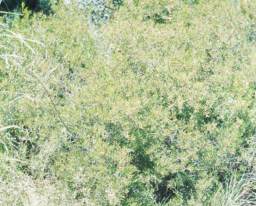Searsia ciliata
Searsia ciliata (Licht. ex Schult.) A.J.Mill.
Family: Anacardiaceae
Common names: sour karee (Eng.); suurkaree (Afr.)
SA Tree No: 380.2
Introduction
Searsia ciliata is one of the more modest members of this popular group of garden plants which hybridize easily. This species, like several others in the family, is a low maintenance shrub and is commonly confused with S. tridactyla. It tends to grow straggly and needs light pruning to keep it shapely.

Description
Description
Searsia ciliata forms an evergreen, thorny, thin and crooked-stemmed shrub from 2 to 4 m high.

The bark is grey, smooth and the branches are spreading white somewhat striate (marked with fine lines, ridges or furrows), often ending in spines. The leaves are trifoliolate (has three leaflets) which is characteristic of the Searsia species.The flowers are minute, yellow-green in colour and insignificant.The fruits are drupes; shiny, light to dark brown in colour. The shape of the fruits is the main distinquishing character between this species and S. tridactyla.
Distribution and habitat
Distribution description
S. ciliata is widespread in two widely separated areas. In Namibia it is found in the central to northern areas roughly between Grootfontein, Otjiwarongo and Windhoek. It is also widespread in the central drier parts of South Africa, such as the Northern Cape ,the western half of the Free State and reaches as far south as north of Middelburg in the central Karroo. It also occurs in the southern most part of Botswana.
Derivation of name and historical aspects
History
Most of the species grown in southern Africa, belonging to the genus Rhus, have been placed in Searsia. Searsia was named after Paul B. Sears (1891-1990) who was head of the Yale School of Botany. Ciliata is the Latin for cilia which refers to the minute hairs along the leaflet margins (Moffet 1994).
The Anacardiaceae family is widespread in the warmer parts of theworld. In South Africa there are about 62 species of Searsia.
A few indigenous species that belong to this family are wild plum,Harpephyllum caffrum; the resin tree Ozoroa species; iron martin, Laurophyllus capensis and marula, Sclerocarya birrea. Some members of the family have edible fruits such as the mango, the cashew nut, the pistachio nut and the marula. Many of these plants produce a resin, gum or latex and some have a highly toxic sap e.g. Smodingium sp., which causes a painful rash that results in blistering. The male and female flowers are often borne separately.
Ecology
Ecology
Fruit-eating birds are very fond of eating these fruits.
Uses
Use
The fruits are edible but not tasty and are eaten by the Sotho people.
It is known as firebush in Namibia where it is used to extinquish fires.
Growing Searsia ciliata
Grow
These shrubs are best grown from seed. The seeds usually have a shiny brown colouring when ripe. As soon as the seeds are dry they can be collected. The seeds are cleaned by rubbing off the outer parts, then dried in the sun, dusted in Bexadust and stored till sowing. The seeds can be sown immediately they are sun dried or stored for one season, sometimes for two seasons, if treated correctly with Bexadust. All Searsia seeds are best sown in spring.
Sow in a medium made up of one part mountain gravel, one part compost/leafmould, and one part red soil. Mix well until you have a very well-drained,loose mixture. No artificial fertilizers should be added.
Seed trays must have good drainage. Scatter the seeds lightly over the prepared, damp sowing mixture. Firm them down lightly. Dust the seed with fine ashes of wood (grey powder), before covering them to keep the insects away. Place the seed tray in a cool, shady,well-ventilated house. The sun should not shine on the seed tray in the germinating stage. Seed starts germinating from 4-6 weeks.some. Germinated seeds should be watered daily, the seedlings damp off when over-watered. As they develop into the third to fourth leaf stage, do not remove the seedlings with a dibber but rather shake the soil out of the pot, wet it and loosen it, so that you do not damage the root system. The transplanting soil mixture is as follows: one part compost/ leaf mould, one part mountain gravel, three parts red soil. Add a handful of bone meal and 3:1:5 or 2:3:2 to transplanting soil mixture. Mix well (Martin Lumley pers. comm.).
Credits
Shireen Harris
Free State NBG
September 2003
Updated July 2008
Plant Attributes:
Plant Type: Shrub
SA Distribution: Free State, North West, Northern Cape
Soil type:
Flowering season: Spring
PH:
Flower colour: Green
Aspect: Full Sun
Gardening skill: Easy
Special Features:
Horticultural zones









Rate this article
Article well written and informative
Rate this plant
Is this an interesting plant?
Login to add your Comment
Back to topNot registered yet? Click here to register.